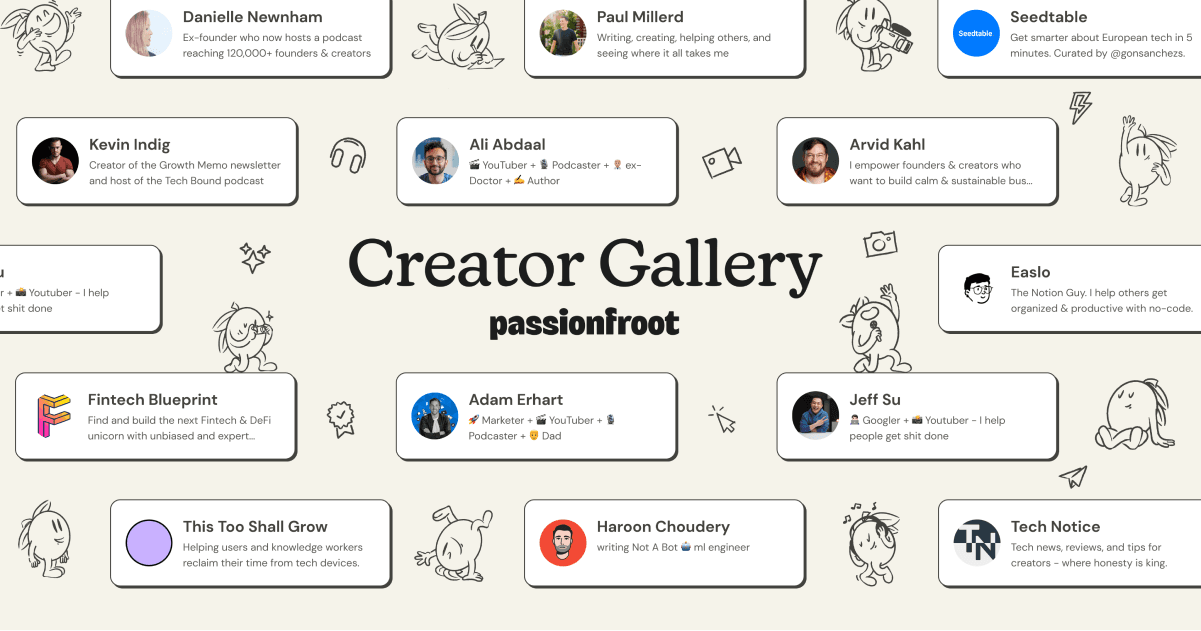Putting your trust as a marketer or brand in 3rd-party social media tools to manage all of your posts can be a bit scary.
You might be wondering:
- Are my posts getting optimal reach and engagement?
- Do social media platforms penalize 3rd-party tools?
- Are 3rd-party tools really worth the cost?
These are some of the most common questions our Customer Advocates receive on a daily basis. And up until this research, we haven’t had any concrete data to say “yes” or “no” to whether or not 3rd-party tools affect the reach and engagement of posts.
We’re hoping to change that.
For an entire month, with the help of several awesome marketers and brands, we tested more than 200 posts across 35 profiles to see exactly how 3rd-party social media tools stack up vs. native posting.
Today we’re excited to share the experiment setup and results in their entirety!
Brief summary of results: 3rd-party tools don’t seem to negatively affect the reach of posts
We’d love to share a quick summary of what we found (you can find the full results and more on how we ran the experiment below!).
Facebook:
- 3rd-Party Tools: 9 posts / 81,639 total reach / 9,071 per post
- Native Posting: 9 posts / 79,380 total reach / 8,820 per post
Twitter:
- 3rd-Party Tools: 45 posts / 949,890 total impressions / 21,108 per post
- Native Posting: 45 posts / 975,223 total impressions / 21,671 per post
LinkedIn:
- 3rd-Party Tools: 9 posts / 63,221 total reach / 7,024 per post
- Native Posting: 9 posts / 54,646 total reach / 6,071 per post
Read on to check out all of the details!
3rd-party social media tools vs. native posting (setup)
In order to make the research as statistically sound as possible, we focused on three important factors:
- Account Variation: Ensuring that we tested multiple 3rd-party social media tools and social accounts
- Content Quality: Ensuring that we tested similar content across platforms
- Posting Consistency: Ensuring that we posted at similar times and frequencies
Our tests ran from November 27, 2017, to December 19, 2017.
Account Variation
Our biggest concern with an experiment like this is that our results would be biased if we only tested Buffer content with the Buffer tool.
We knew it would take multiple marketers and tools to make the data meaningful.
First, we signed up for test accounts with Hootsuite and CoSchedule. This would allow us to test three different 3rd-party social media tools to reduce the chance of a particular tool playing a factor in reach and engagement.
Then, we turned to the Social Media Masterminds Facebook Group and asked if any marketers would be up for helping us run a few tests. The response was incredible…
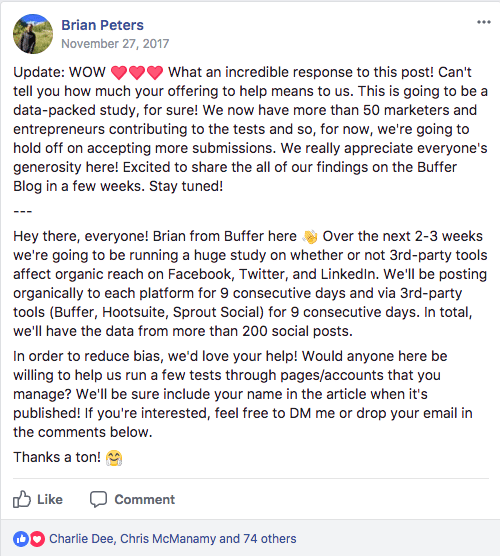
Judging by the number of comments and overall enthusiasm for this experiment, we knew we were onto something.
In the end, we received data from 11 different brands, totaling more than 98 posts across Facebook, LinkedIn, and Twitter. Factoring in these results to the overall findings greatly helped to reduce any biased data. A huge thanks to everyone that participated!
Now we just had to figure out how we would approach content.
Content Quality
Content presented a unique challenge in that we had to be strategic about what we posted and when we posted it.
As many marketers know, posting the same content multiple times in a short period of time might result in a decrease of reach and engagement with each post.
We ultimately decided that we would not post the same content multiple times. Rather, we would post three different types of content (links, images, videos) and do our very best to ensure that each piece of content was super high-quality.
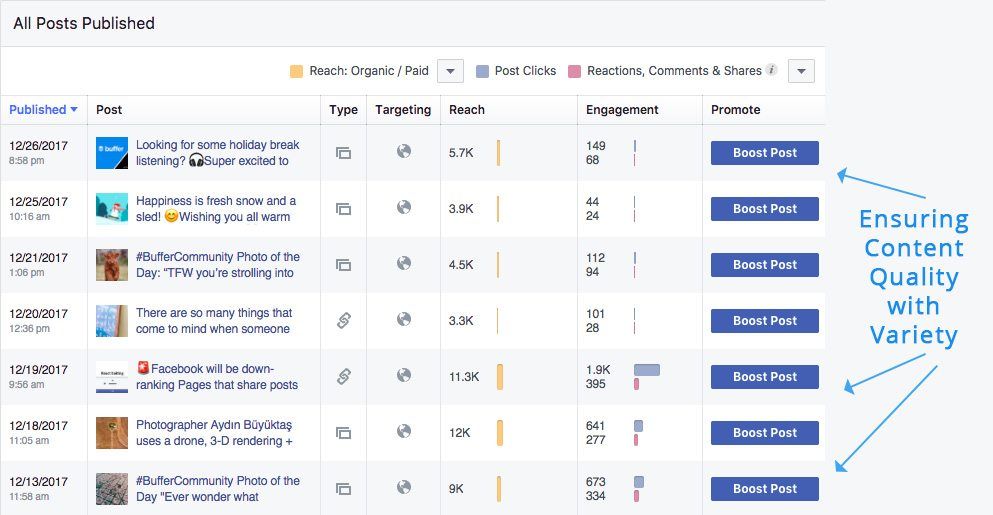
But what we realized is that, at the end of the day, it’s nearly impossible to create truly equal content – some posts will inevitably perform better than others based on a hundreds of different algorithm factors.
In short, content is the number one factor that determines success on social media.
More on the implications of social media content later in this post!
Posting Consistency
The final factor that we focused on for this experiment was to ensure that we were posting consistently. Both timing and frequency impact social media results and so we did our best to post at roughly the same time and frequency each day.
- Facebook: Posted once per day between 6:00am & 12:00pm PST.
- Twitter: Posted 3-5 times per day between 5:00am & 10:00pm PST.
- LinkedIn: Posted once per day between 6:00am & 12:00pm PST.
Posting natively proved to be the most difficult part of this experiment! We found that without 3rd-party social media tools we were having to set reminders in our calendar in order to post at the correct times.
Multiplying that by eight posts per day and three social media accounts, we did end up missing a few posts here and there which prolonged the study.
Last, but not least. It might be helpful to provide the Buffer audience sizes on each network.
Current Buffer Audience Sizes:
- Facebook: 106,000
- Twitter: 927,000
- LinkedIn: 16,500
3rd-party social media tools vs. native posting (results)
Now for the fun part!
Do 3rd-part tools negatively affect reach and engagement on social media?
Data-Backed Answer: No.
We did not find a significant difference in social media reach and engagement whether we posted through 3rd-party tools or natively to each network. As you might expect, some pieces of content performed better than others no matter how they were posted.
If you’re interested in seeing all of the raw data from our experiment, feel free to check out the original spreadsheet where we kept track of every single post.
And if you’d like to run your own 3rd-party tools vs. native posting experiment, we’re happy to share the blank spreadsheet template:
Total Reach
First, let’s take a look at the main component of our experiment – how 3rd-party tools performed vs. native posting in regards to reach/impressions on each social media network.
Facebook:
- 3rd-Party Tools: 9 posts / 81,639 total reach / 9,071 per post
- Native Posting: 9 posts / 79,380 total reach / 8,820 per post
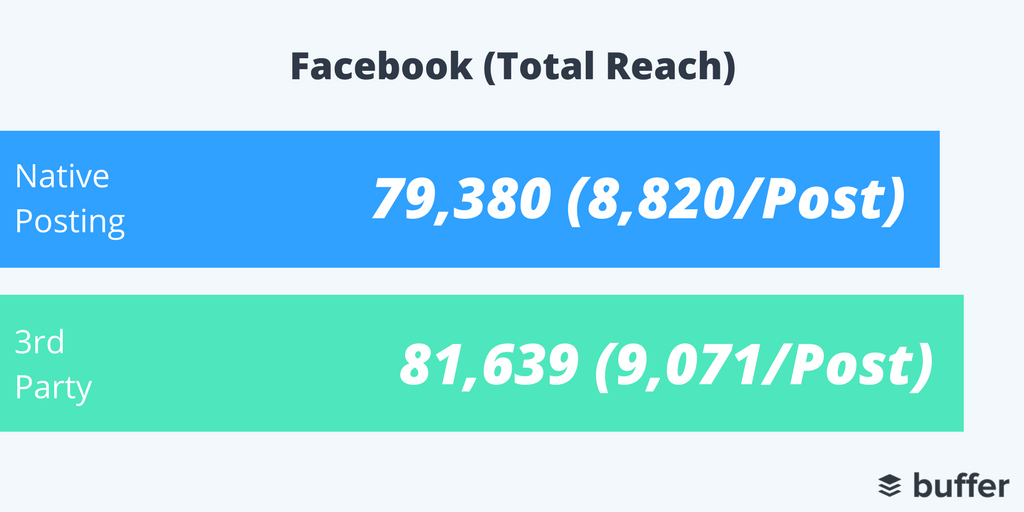
Slight Advantage: 3rd-Party Tools
Twitter:
- 3rd-Party Tools: 45 posts / 949,890 total impressions / 21,108 per post
- Native Posting: 45 posts / 975,223 total impressions / 21,671 per post

Slight Advantage: Native Posting
LinkedIn:
- 3rd-Party Tools: 9 posts / 63,221 total reach / 7,024 per post
- Native Posting: 9 posts / 54,646 total reach / 6,071 per post

Slight Advantage: 3rd-Party Tools
Average Reach Per Post Type
Next, we thought it would be useful to break down how each post type (links, images/GIFS, videos) performed with both 3rd-party social media tools and native posting.
Link Posts:
- Average Link Post Reach (Facebook, 3rd-party): 7,333
- Average Link Post Reach (Facebook, Native): 7,332
- Average Link Post Impressions (Twitter, 3rd-party): 20,326
- Average Link Post Impressions (Twitter, Native): 18,931
- Average Link Post Reach (LinkedIn, 3rd-party): 6,125
- Average Link Post Reach (LinkedIn, Native): 5,852
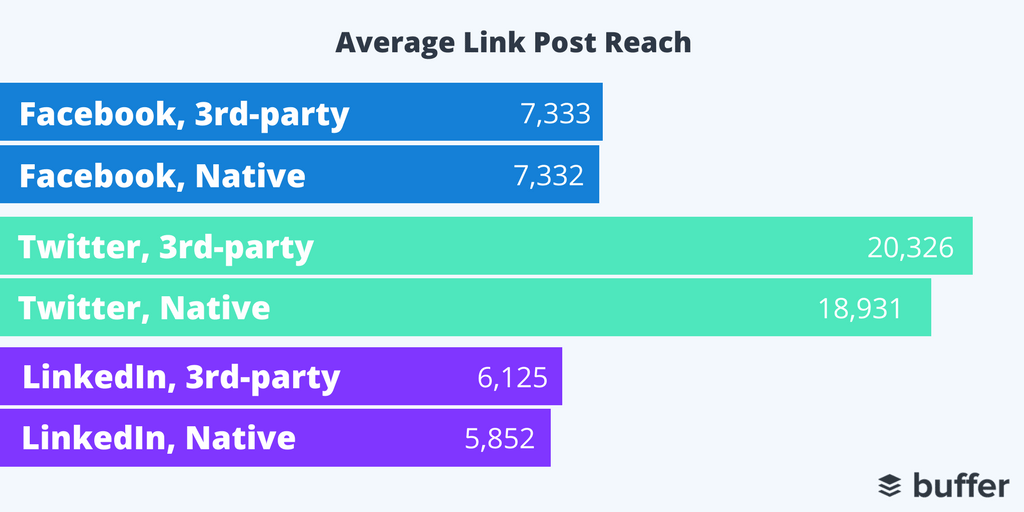
Images/GIFs Posts:
- Average Image/GIF Post Reach (Facebook, 3rd-party): 5,733
- Average Image/GIF Post Reach (Facebook, Native): 8,237
- Average Image/GIF Post Impressions (Twitter, 3rd-party): 19,522
- Average Image/GIF Post Impressions (Twitter, Native): 22,914
- Average Image/GIF Post Reach (LinkedIn, 3rd-party): 8,148
- Average Image/GIF Post Reach (LinkedIn, Native): 6,247
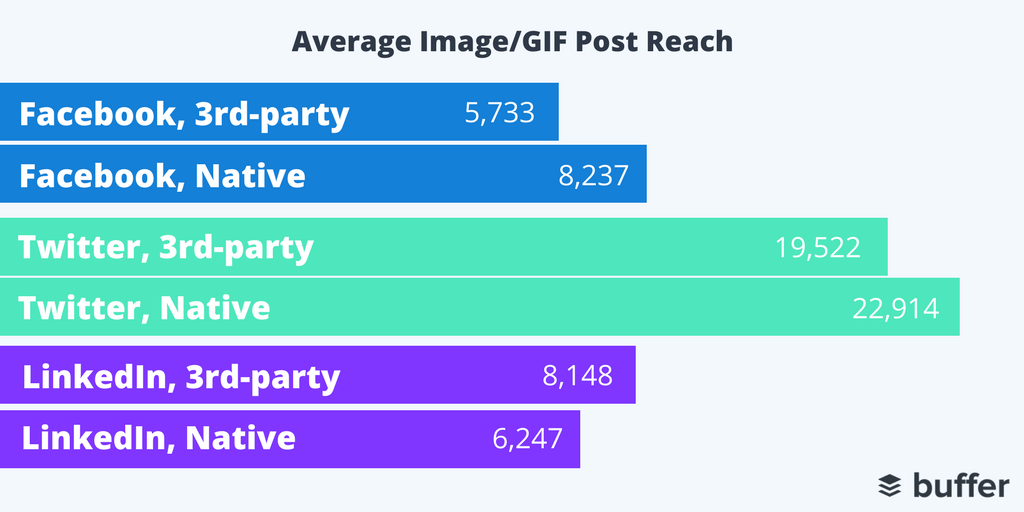
Video Posts:
- Average Video Post Reach (Facebook, 3rd-party): 14,146
- Average Video Post Reach (Facebook, Native): 17,100
- Average Video Post Impressions (Twitter, 3rd-party): 26,495
- Average Video Post Impressions (Twitter, Native): 24,214
- Average Video Post Reach (LinkedIn, 3rd-party): N/A
- Average Video Post Reach (LinkedIn, Native): N/A
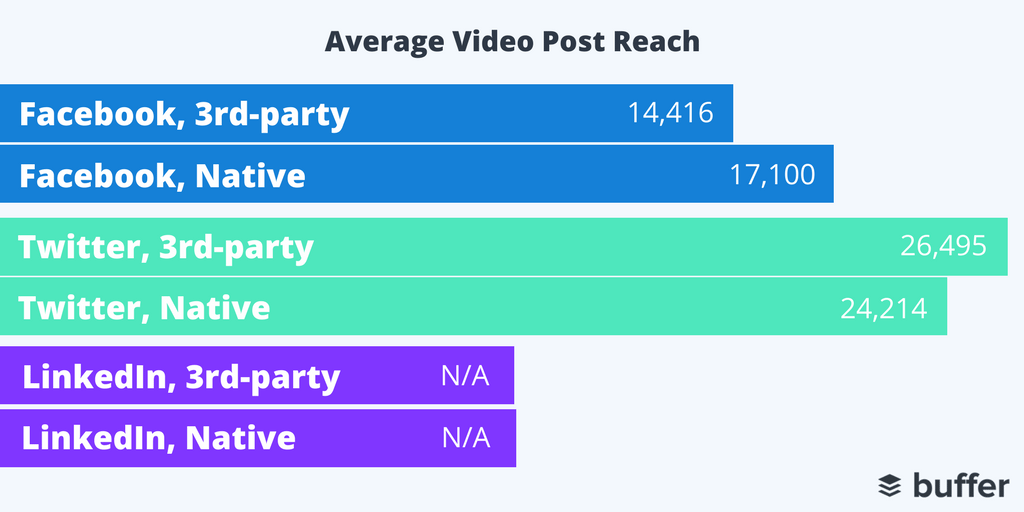
It’s interesting to note that in all cases there was no clear winner between 3rd-party social media tools and native posting. Each performed better seemingly at random – making their performance more or less even across the board.
Which leads us to the 3 major takeaways that we got from this experiment.
3rd-party social media tools vs. native posting (takeaways)
This experiment was an eye-opening one, to say the least! It gave us a great perspective on the current state of social media reach and engagement while also reminding us how much time and effort goes into creating great content.
We’re excited to share the three biggest takeaways we learned in the process.
1. Importance of Content
The number one takeaway that we got out of this experiment is that content is the most important factor that determines social media posting success.
It matters more than timing and frequency. And it matters more than whether or not we posted natively to each network or through a 3rd-party social media tool.
In examining the data, there were times when a piece of content “went viral” when posted natively and there were times when content “went viral” when posted through a 3rd-party tool.
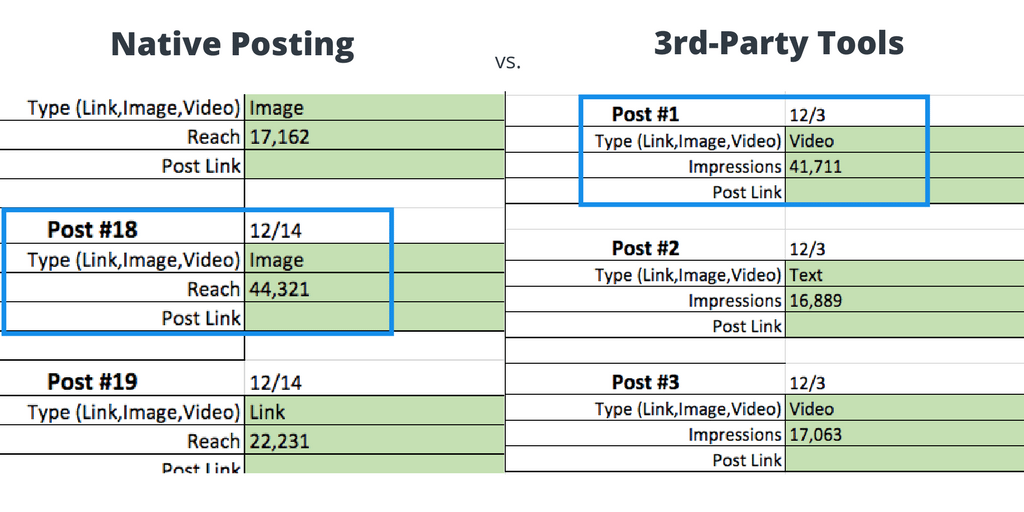
We’ve had the pleasure of running multiple experiments over the past year and it always comes down to the same thing: content.
For example, simply reducing our posting frequency and focusing on only creating content that we knew our audience would love, we were able to increase our Facebook organic reach by more than 330 percent in 2017.
Sometimes all it takes is a fresh perspective on the types of content we create:
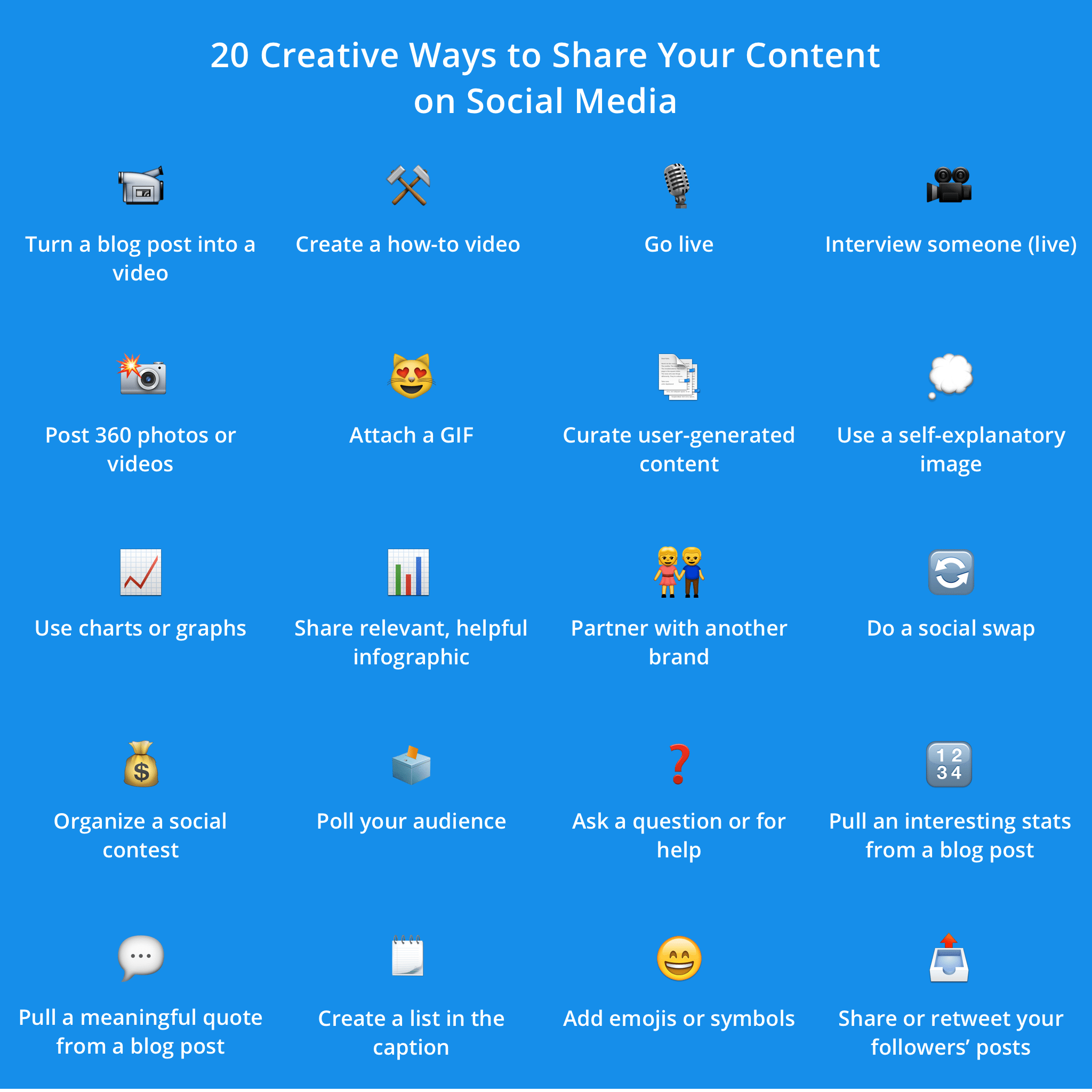
If you’re looking for a fun way to switch it up and create a ton of high-quality posts in 2018, feel free to check out 20 social media content ideas that have worked for us and just might work for you, too!
2. Power of Video
We’ve talked about the importance of video marketing lots here on the blog in the past – we even mentioned the video trend in a recent episode of the Buffer Podcast.
Now we’re excited to say that we have our very own data to back it up!
Here’s how videos stacked up in terms of reach and engagement on Facebook and Twitter in comparison to links and images/GIFs:
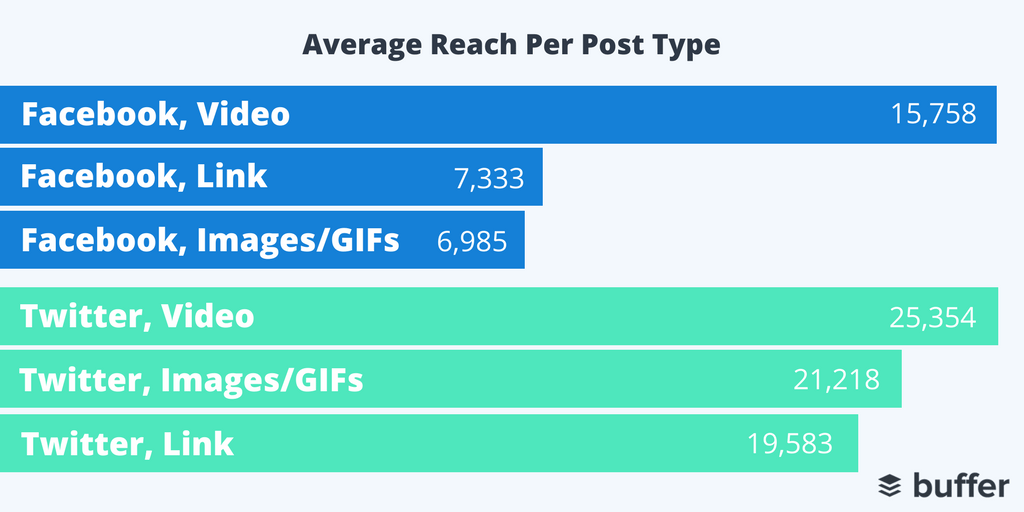
LinkedIn doesn’t currently offer native video posting for brands and so we weren’t able to test the data from that network. But rumor has it that they’ll be opening up native video posting for brands sometime in 2018 (yes!).
Whether networks are prioritizing videos in their algorithms or people truly do enjoy interacting with video over other types of posts, we can expect to see a lot more of them in the coming year.
3. Time and Productivity
Folks that work and are successful in the social media industry know that it can take lots of time and effort to create amazing content and grow accounts.
That’s why we’re huge fans of anything that can make our jobs that much easier – extensions, hacks, tools, you name it!
Planning, uploading, and posting to social media natively turned out to be a major challenge for us. We often found ourselves forgetting to upload a Tweet or Facebook post at a certain time.
And quite ironically, when posting natively, we ended up using Buffer to “store” all of our content so that we could quickly copy and paste the image and caption to each social network. We’re not sure what we would have done without that over the course of the three weeks.
For us, utilizing a social media tool like Buffer, Hootsuite, CoSchedule (or any of the other great tools out there) is how we’re able to ship great content consistently and on time.
Thoughts and next steps
At this point you might be eager to run some 3rd-party vs. native posting experiments of your own. I know I would be!
While it’s great to read studies like this one, every brand’s results on social media might look a little different. You might rest a little easier at night knowing for sure that your social media posts aren’t being penalized for using a 3rd-party tool.
If you’re interested, you can grab a copy of the blank spreadsheet template here:
Download: 3rd-Party Tools vs. Native Posting Results (Blank .XLS)
Or, check out the raw data from our experiment, including the results from 11 other brands:
Results: 3rd-Party Tools vs. Native Posting (Buffer + Community)
I’d love to hear the results of your experiments!
Please feel free to leave a comment below with any questions about the experiment or results above, or your own experience with 3rd-party social media tools vs. native posting.
A huge shoutout
We wanted to say thank you for all of the wonderful people and brands that helped to make this study great!
- Bella Vasta – Jump Consulting
- Roza Tsvetkova – Komfo
- Dustin Stout – dustn.tv
- Yaniv Goldenberg – Elementor
- Karen Freberg – University of Louisville
- Ysmay Walsh – Shankman.com
- Sheldon Payne – Newfound Marketing
- Mana Ionescu & Allie Barke – Lightspan Digital
- Kara Lambert – KaraLambert.com
- Two others that would like to keep their information private
Try Buffer for free
190,000+ creators, small businesses, and marketers use Buffer to grow their audiences every month.

